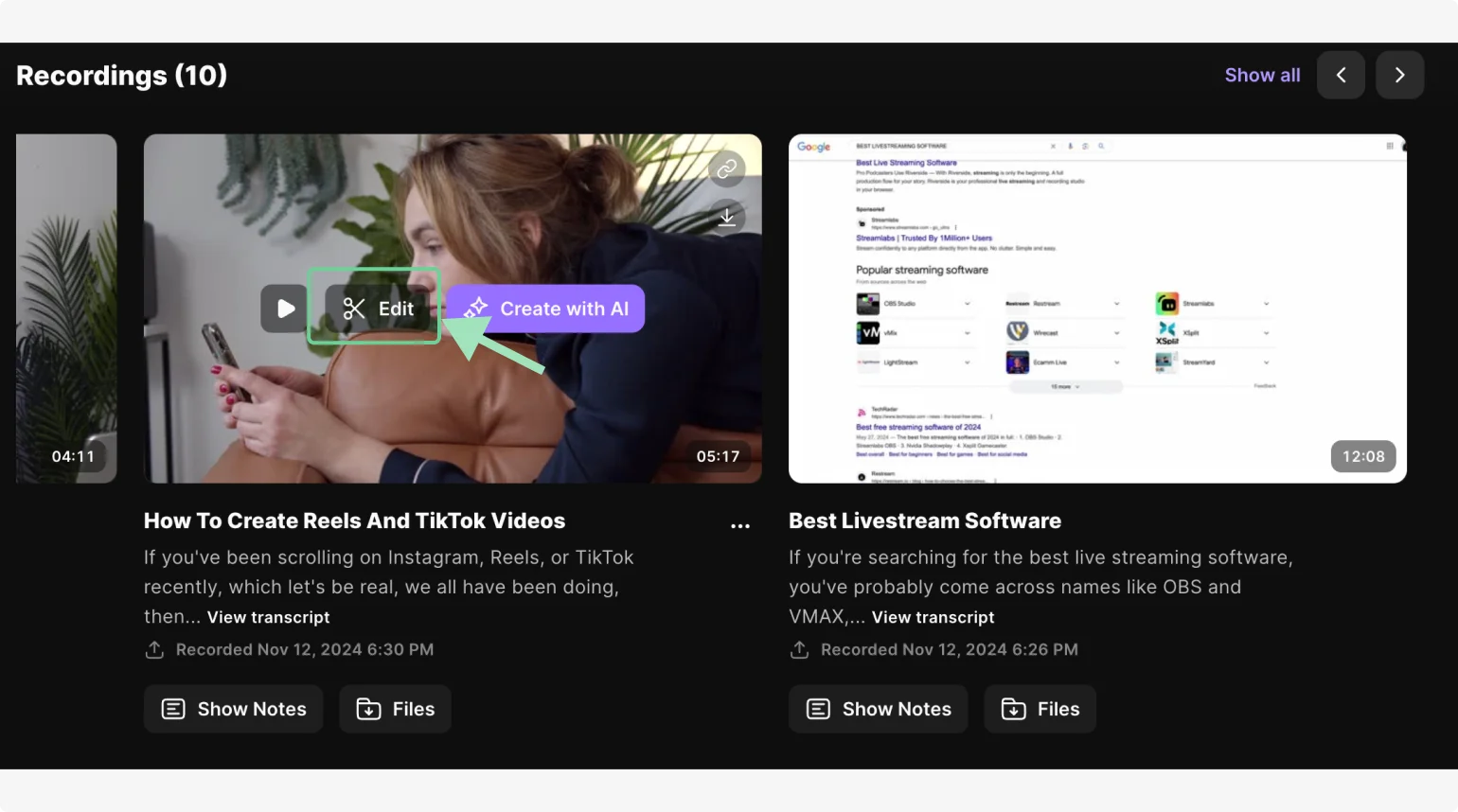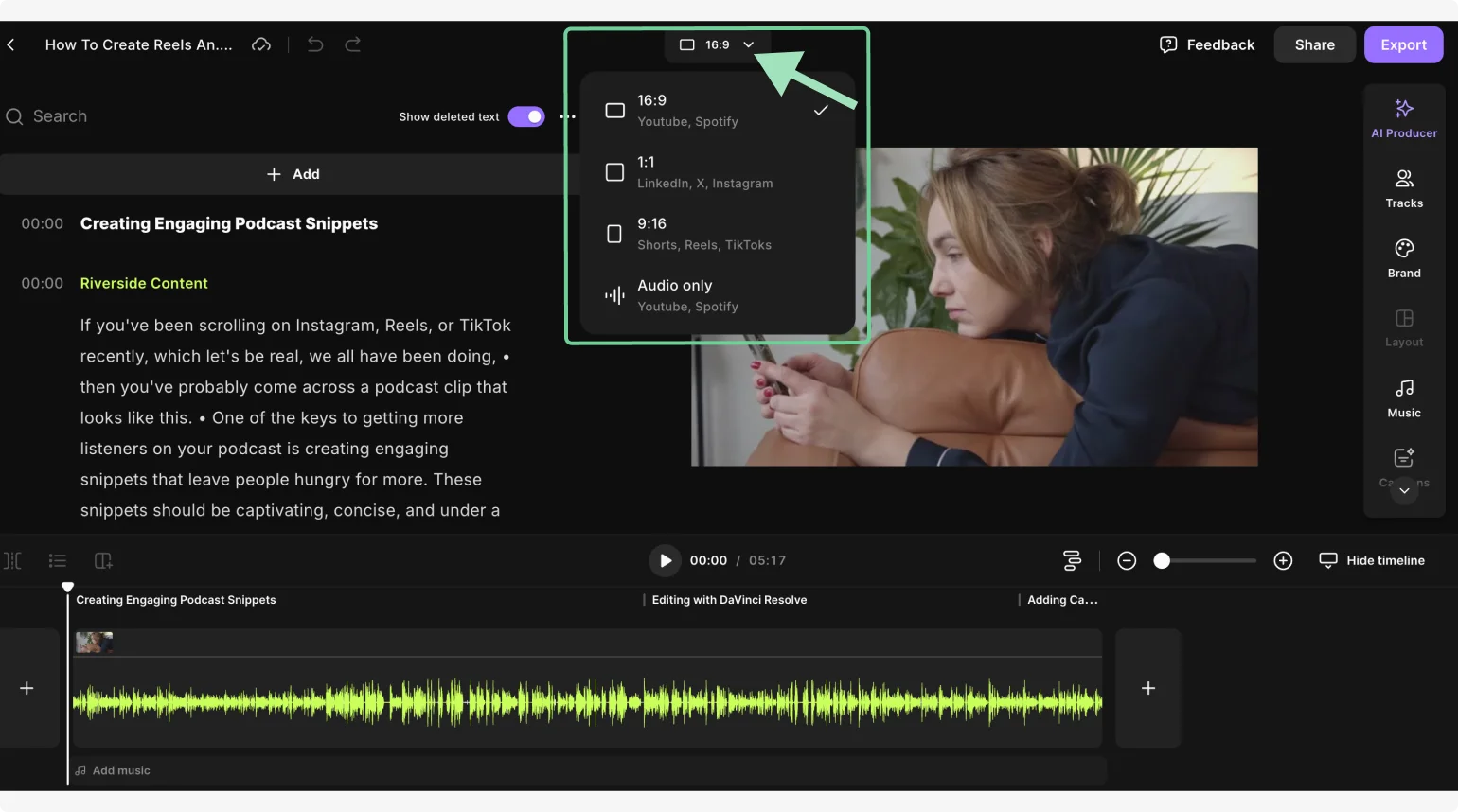Table of contents:
Key Takeaways
To summarize, this is what to keep in mind when choosing the ideal size for your YouTube videos:
- Aspect Ratio: YouTube supports 16:9 for most desktop videos and 9:16 for vertical content like YouTube Shorts.
- Resolution: Resolutions range from 240p up to 4320p (8K UHD), with 1080p (FHD) and 4K as common choices for high quality.
- Dimensions: Dimensions vary by aspect ratio, with popular sizes like 1920x1080 for 16:9 and 1080x1920 for 9:16, covering HD and UHD options.
- Video Format: The recommended upload format is .MP4 with H.264 video codec and AAC-LC audio codec; YouTube also supports .WMV, .AVI, .MOV, and .FLV.
You've poured hours into creating your YouTube video. But before you hit “upload,” a crucial question arises - what dimensions will make your video look its best?
With so many options for quality, format, aspect ratio, and resolution, figuring out the ideal setup can feel overwhelming.
Don't worry. In this guide, we’ll break down YouTube’s recommendations and explain the best dimensions to ensure your videos look best.
The best YouTube video dimensions and resolutions
Resolution, dimensions, and aspect ratio are all interconnected and work together to determine the overall quality of the video.
Here’s a table that recaps the dimensions, resolutions, and quality supported by YouTube for the two most widely used aspect ratios (16:9 and 9:16).
But, let’s break this down to clarify the difference between resolution and dimensions, and how these factors affect video quality.
Resolution
Resolution is the amount of detail in a video, measured by the number of pixels.
YouTube supports a wide range of resolutions between 240p and 8K, but doesn’t recommend any one in particular. However, it’s best to record your videos at a resolution of at least 720p for desktop viewing and 480p for smartphones. Higher resolutions like 1080p are generally preferable across all devices.
To understand this better, you need to know that the quality of a video is determined by its resolution or the number of pixels in each frame. The higher this number, the better the quality. For example, a 1080p full high-definition (FHD) video will look crisp and clear because it includes more pixels. A 360p, standard definition (SD) video may look muddy and blurry because it has fewer pixels.
Higher resolutions look better on larger displays, while lower ones are usually fine for smaller displays. For example, if you’re watching on your smartphone, a 480p video will usually look sharp enough. The same resolution, however, will look blocky and choppy on a massive 65” OLED TV.
Dimensions
The dimensions of a video are the actual pixel measurements, expressed as its width and height in pixels. Together with the aspect ratio, dimensions determine the resolution of a video.
YouTube doesn’t recommend specific dimensions. However, since the recommended aspect ratio for standard videos is 16:9, and the resolution should be at least 240p or higher, the preferable dimensions and resolutions are as follows:
The best YouTube aspect ratios
The aspect ratio of a video is the proportional relationship between its width and height. It’s expressed as two numbers. The only aspect ratios explicitly recommended by YouTube are 16:9 (widescreen) for desktop and 9:16 (vertical) for YouTube Shorts.
While other aspect ratios, like 4:3 (used for older TV formats) or 1:1 (square), are also supported, YouTube will automatically adjust the display to fit the screen. This means black bars will be added on the sides or top and bottom of the video to compensate for the empty space.
Here is a quick recap of the four video aspect ratios most commonly used on YouTube:
The best YouTube video format
The video format recommended by YouTube is the MPEG-4 file format version 2, also known as MP4. This format is one of the most widely used thanks to its versatility, smaller file size, and excellent video quality. Due to these characteristics, MP4 is usually the preferred YouTube video format, as it ensures fast uploads, smooth processing, and optimal playback on any device.
According to YouTube's official support, the recommended specifications for MP4 files are:
- Video codec: H.264
- Audio codec: AAC-LC
- Audio bitrate: 96 kHz or 48kHz
- Frame rate: Videos should be encoded and uploaded in their native frame rates (24, 25, 30, 48, 50, 60 fps).
Make sure your YouTube video editing software, like Riverside, is compatible with this.
If you're uploading high-quality broadcast files or original DVD-compliant MPEG-2 streams, YouTube recommends using MPEG-2 files with the following specifications:
- Audio codec: MPEG Layer II or Dolby AC-3
- Audio bitrate: 128 kbps or better
If you can’t use one of the two file formats listed above, YouTube supports a variety of other formats:
- MOV
- MPEG-1
- MPG
- AVI
- WMV
- MPEGPS
- FLV
- 3GPP
- WebM
- DNxHR
- ProRes
- CineForm
- HEVC (h265)
Audio file tracks are accepted in the following formats on YouTube:
- MP3
- WAV (AAC or MOV)
- FLAC
Maximum YouTube video length and size limit
The maximum video length on YouTube is:
- 15 minutes for unverified accounts.
- Up to 12 hours or have a maximum file size of 256 GB (whichever is reached first) for verified accounts.
Note that older videos that exceed the 12-hour limit might still be available on YouTube since these time limits are adjusted over time.
YouTube video thumbnail sizes
The recommended image sizes for thumbnails are 1280x720 or 1920x1080, with an aspect ratio of 16:9. Thumbnails are small screenshots of the video that will show in search results and in the list of videos inside your YouTube channel. Together with the title, they can make or break your videos, as they determine whether people will click on them or not.
Why two different image sizes? It depends on your video’s resolution. You can extract a 1280x720p screenshot from a 720p video. You can extract a 1920x1080 screenshot from a 1080p video. You could also extract a 1280x720p screenshot from a higher resolution video, but we recommend going for the highest quality available.
Note that if you used a different aspect ratio for your video (like a 4:3 or 1:1), your thumbnail won’t fit the frame and YouTube will fill the missing space with a blurred, magnified background. This doesn't always look great. Since they're so important, we recommend testing thumbnails on different devices (smartphones, desktop, and TVs) to ensure sure they look the way you want them to.
Video specs for other types of YouTube videos
Other video types may have slightly different requirements and specifications. Let’s take a look at the main differences.
Shorts
YouTube Shorts are designed specifically for vertical orientation, and they’re optimized for a mobile-first viewing experience. They’re YouTube’s answer to the short clips featured on other social media platforms like TikTok and Instagram Reels.
Here are the unique specs for Shorts:
Aspect Ratio: 9:16 (vertical) is ideal, but 1:1 (square) can also be used.
Resolution and dimensions: YouTube does not specifically recommend a resolution. But for best results, you should opt for a minimum of 480p on mobile (or 720p on desktop) and a maximum of 1080p, with the following dimensions:
- 1080x1920
- 720x1280
- 480x854
Video Length: Shorts can last no longer than 60 seconds. There’s no minimum length, although less than 15 seconds is generally not recommended.
Format: MP4 is the preferred format here as well.
Maximum File Size: 256 GB
Ads
These are the specifications for YouTube ads:
- Aspect Ratio: 16:9 (horizontal), 9:16 (vertical), or 1:1 (square).
- Resolutions: YouTube recommends a resolution of 1080p, although 720p is also accepted. SD (480p) is also supported but explicitly not recommended.
- Dimensions: some text
- 1920 x 1080px (horizontal)
- 1080 x 1920px (vertical)
- 1080 x 1080px (square)
- 1280 x 720px (horizontal)
- 720 x 1280px (vertical)
- 480 x 480px (square)
- Format: YouTube recommends using .MPG (MPEG-2 or MPEG-4), but the usual list of formats is also supported.
- Maximum File Size: 256 GB
How to resize your YouTube videos
If you recorded your video in a less-than-optimal aspect ratio, you can easily resize it with a video editor like Riverside.
Follow these simple steps to switch the aspect ratio of your videos with just a few clicks. Let’s start with the desktop version.
Switching aspect ratio with Riverside (desktop)
Step 1: Open the Riverside editor
From your Riverside dashboard, click on a relevant Project.
Hover over the video you want to edit, then click “Edit” to open the editor.

Step 2: Change the aspect ratio
Click on the rectangle button at the top of your screen to switch your video’s aspect ratio (16:9, 9:16, or 1:1).

Once you’re finished, export your video by clicking on the purple “Export” button on the top right corner of the screen. Your video file will appear on your dashboard. Save it to your device by clicking the download arrow.
Now you can upload your video on YouTube with your preferred aspect ratio.
Switching aspect ratio with Riverside (mobile)
If you’re using Riverside's mobile app (it’s free!), you can change the aspect ratio of your video very quickly by following these steps:
Step 1: Open the Riverside app
Log into your Riverside app and select the video you want to edit.
Access the editor by tapping on “Create new edit.”
Step 2: Change the aspect ratio
To change to the desired video’s aspect ratio (16:9, 9:16, or 1:1), tap the aspect ratio button at the bottom of your screen.
.webp)
Once you’re finished, access the “Export” dialog box by tapping the purple icon in the upper right corner of your screen.
Here, export your video file by tapping the purple “Export video” button at the bottom of the screen. Your file will appear on your dashboard where you can download it. (Click on the export and then select the “Save” button.)
You can now upload your video to YouTube.
Final thoughts
Before you upload your video to YouTube, it’s essential to optimize its dimensions, resolution, aspect ratio, and format to ensure your content looks good (and plays smoothly).
Now that you know the right dimensions and formats, you can ensure that your videos look their best. And, if you need to quickly switch aspect ratios, try Riverside.
FAQs on YouTube video size
Here are the answers to some of the most frequently asked questions (FAQs) on YouTube video sizes.
Are YouTube videos 1920x1080?
YouTube supports a wide range of resolutions and video dimensions, and 1920x1080 (1080p) is just one of them. However, it can be considered the standard since it’s the recommended format for most YouTube videos and ads on both desktop and mobile.
Are YouTube videos 16x9 or 4x3?
The standard aspect ratio for YouTube videos is 16:9, the recommended widescreen format used by most videos. YouTube also supports 4:3 for older or retro-style videos. On desktop, these will appear with black bars at the top and bottom.
How can I convert videos from one format to another before uploading to YouTube?
To convert your video to a YouTube-compatible format before uploading, you'll need to:
Choose a video converter. (There are many options online.)
Upload your video into the converter and choose your output format. To stay compatible with YouTube, et the output to MP4 with H.264 video codec and AAC audio codec.
Finally, you can convert and download your new video file.
How do different video dimensions affect the quality of YouTube videos?
Higher dimensions affect the resolution of a video, which in turn determines its overall quality. For example a 2560x1440 dimension corresponds to a 1440p video in 16:9, while 1280x720 corresponds to a 720p video, still in 16:9. This means that the image quality of the first will look crisper and sharper than the second, and will be especially noticeable on larger displays like a smart TV.

.webp)
.webp)











.webp)




